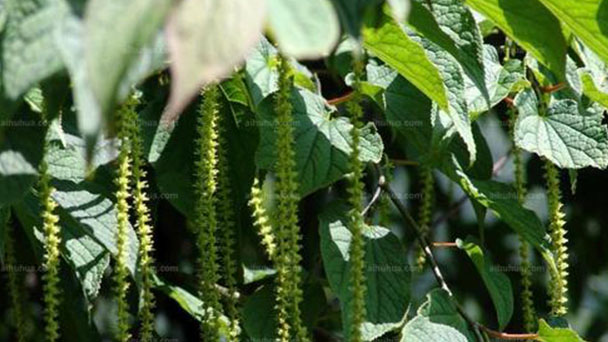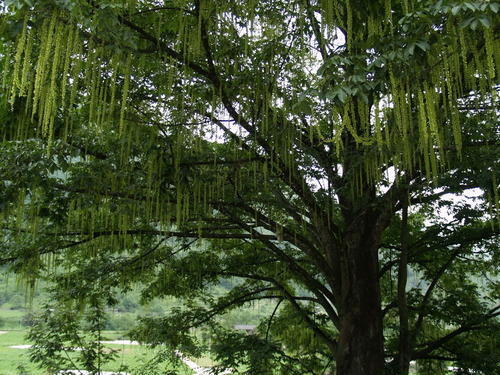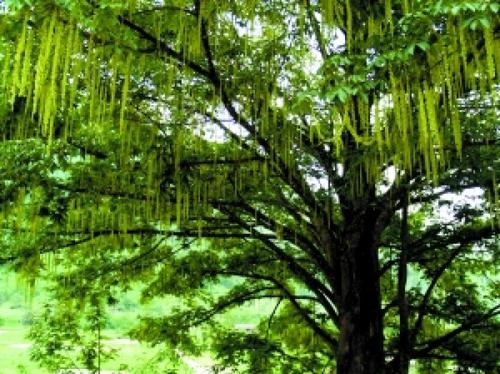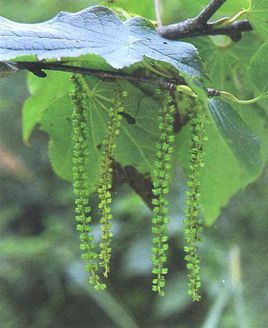Tetracentron profile
Written by Maggie
Mar 24 2021

Tetracentron, a rare species, is a rare deciduous tree of Tertiary ancient relict. Tetracentron is distributed in southern Shaanxi, southeastern Gansu, central and southern Sichuan and other places, and is born in or on the edge of evergreen and deciduous broad-leaved forests at elevations of 1100 ~ 3500 meters. It is distributed in Shaanxi, Gansu, Hubei, Sichuan, Guizhou and Yunnan provinces of China and in northern India, northern Myanmar, Nepal and Bhutan.
Tetracentron's wood is of great scientific value in the study of the evolution of the ancient Chinese flora, angiosperm system and origin.
Tetracentron is a class II protected tree species.
Tetracentron picture

Tetracentron info
| Botanical Name | Tetracentron sinense |
| Common Names | tetracentron |
| Plant Type | Tree |
| Sun | Full sun to part shade |
| Hardiness Zones | 6 to 7 |
| Flower color | Yellowish-green |
| Native Area | Southwest and central China, northern Burma |
| Mature size | 30.00 to 40.00 feet tall, 20.00 to 30.00 feet wide |
Morphological characteristics of the Tetracentron
Strain
Tetracentron is a tree with a height of 30 m and a diameter at breast height of 1.5 m. The whole plant is glabrous. Bark is grayish brown or grayish brown reddish, flaky abscission; Long branches are terminal, slender, dark reddish-brown when young, short branches lateral, SPAR, the base of a stack of annular leaf marks and bud scales.
Leaf
The leaves of Tetracentron are ovate-cordate, 7-15 cm long and 4-11 cm wide, acuminate at the top, cordate at the base, serrulate at the margin, glandular at the tip of the teeth, glabrous on both sides, slightly glaucous on the back, palmate veins 5-7, and an inconspicuous network at the near edge; Petiole is 2-3.5 cm long.
Flowers
Tetracentron has small spikes of drooping flowers at the top of short branches and many flowers; Flowers are 1 -- 2 mm in diameter, perianth pale green or yellow-green; Stamens are opposite to perianth segments, 2.5 times as long as the perianth, anthers oval-shaped, lobed longitudinally; The carpel is joined along the abdominal suture.
Fruit
Fruit Tetracentron is oblong, 3-5 mm long, brown, dehiscent along dorsal suture; Tetracentron has 4-6 seeds, bar, 2-3 mm long.
The ecological habits of Tetracentron
Tetracentron has a wide distribution area. The climate of its producing area is warm and cool, rainy, with a long fog period and high humidity. The annual average temperature is 7.2-17.5℃, the annual precipitation is 1000-1800 mm, and the relative humidity is about 85%. The soil is acidic, mountain yellow soil or yellow brown soil, pH 4.5-5.5. Tetracentron is a deep-rooted, photophilic, positive tree, which is slightly shade-tolerant in its young age. It is born in a deep soil layer, loose, moist, rich humus, good arrangement of the valley and mountain abdomen, and can also grow on the hanging rock of steep slope and deep valley. Sporadic in evergreen, deciduous broad-leaved forest or forest margin. When the evergreen and deciduous forests are destroyed, Tetracentron often grows into pure blocky forests.
Tetracentron likes warm climates, but it is not resistant to heat and humidity, so it grows poorly in overheated climate. Yunnan is mainly distributed in the area of 1200-2400 meters above sea level. The cold resistance is not strong, and it can only withstand the low temperature of -7℃ for a short time. If the temperature is at -5℃ for 2-3 days, it will cause different degrees of freezing injury, the light one will die, the heavy one will die. Tetracentron likes light, and a little shade can slow growth. Tetracentron likes fertile wet acid soil. In a good environment in Kunming, the 1-year-old seedlings can reach 1.5-2 meters in height, the 3-year-old seedlings can reach 9 meters in height, the 10-year-old seedlings can reach 20 meters in height, and the 20-year-old seedlings can reach 30 meters in height. After that, the seedlings grow slowly, the 6-year-old seedlings can blossom and bear fruit, and the seedlings will reach the full fruit stage after 15 years.
Tetracentron is born in broad-leaved forests in gullies or hillsides at an altitude of 1600-2200 meters. It is mixed with many trees, such as Chestnut of Tetracentron.

Disease control of Tetracentron
Insect pests
Tetracentron is susceptible to yellow ants.
Method of prevention and cure
After transplanting, 500 grams of diazinon granules (10%) per mu or 1 kg of phoxim (3%) per acre were mixed with chemical fertilizer and applied around the pond and mixed well with soil to control the harm of yellow ants.
Tetracentron's distribution area
Tetracentron is also found in Nepal and northern Myanmar.
Tetracentron uses
Landscape use of the Tetracentron
Tetracentron has beautiful tree shape and dancing tree posture, which is suitable for cultivation as ornamental and street tree.
Research value
Tetracentron is a living fossil left in the Tertiary period. The fossil of Tetracentron was found in the Eocene epoch of Cenozoic era. It is an ancient relict plant.
Tetracentron is a national protected wild plant. It is of great value to study the origin of angiosperms because of its ancient origin, isolated systematic location and special ecological environment.
The economic value
Tetracentron's wood is of solid quality, compact structure and beautiful texture. It is used as raw materials for furniture and paper making. Wood gray or light grayish brown, heartwood is not obvious, no special smell, straight texture, coarse structure, growth round is obvious, quality light and soft.

Latest Updated
- Benefits of Bugleweed - 7 Science-backed Health Benefits
- Bugleweed Dangers & Side Effects - Is It Poisonous?
- How to Plant Evergreen Trees - What You Should Know
- When to Plant Evergreens - Grow Guide for Evergreen Trees
- 12 Wonderful Evergreen Shrubs for Your Garden
- 12 Popular Evergreen Plants with Pictures for Beginners
- When And How To Prune A Lilac Bush Like a Pro
- How to Grow & Care for Lilac Vine (Hardenbergia Violacea)
- Japanese Lilac Tree (Syringa Reticulata) Care & Propagation Guide
- Shumard Oak Pros and Cons - What to Know
Popular Articles
- Winter maintenance of Antirrhinum Majus
- How to Grow Terminalia Mantaly Tree
- How to Grow and Care for Crossostephium Chinense
- How to grow Antirrhinum Majus in spring
- Peristeria Elata (Dove Orchid) Profile: Info & Care Guide
- Underwatered Snake Plant (Sansevieria Trifasciata) - Signs And How To Fix
- How to Care for Brazilian Jasmine Plant (Mandevilla Sanderi)
- How to Grow & Care for Graptopetalum Purple Delight in Summer
- Rosa Chinensis (China Rose): Plant Growing & Care Tips
- How to Care for Baby Sun Rose (Aptenia Cordifolia)